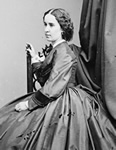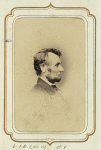Collection Overviews
Table of ContentsBackground and Scope of the CollectionIntroductionIn 1954 the Library of Congress purchased from Alice H. Cox and Mary H. Evans, the daughters of Levin C. Handy approximately 10,000 original, duplicate, and copy negatives. The L.C. Handy Studio had been located at 494 Maryland Avenue SW, Washington, DC. Levin C. Handy (1855?-1932) was apprenticed at the age of twelve to his uncle, famed Civil War photographer Mathew B. Brady (1823?-1896). Handy became an independent photographer and over the years owned studios in partnership with Samuel Chester and with Chester and Brady. The Maryland Avenue studio was the most permanent and was the place where Levin Handy resided at his death in 1932. In the 1890s Brady himself had worked and lived at the Maryland Avenue address. E. and H.T. Anthony acquired Brady's Civil War negatives as payment for his debt to that photographic supply company. These negatives, distinguished by the prefix LC-B8, were purchased by the Library in 1943 and are known as the Civil War Photographs Collection. They are available separately through the Prints and Photographs Online Catalog. The remaining negatives in the Brady-Handy studio that came to the Library through the 1954 purchase are known as the Brady-Handy Collection and are distinguished by the prefix LC-BH8. The majority of the Brady-Handy negatives are of Civil War and post-Civil War portraits, with a small collection of Washington views. The online collection shown here includes primarily original glass plate negatives. Many duplicate and copy negatives were not scanned. Brady, Handy and Their StudiosMathew BradyIn the mid-nineteenth century, Mathew Brady operated one of the most prominent portrait studios in New York City and Washington, D.C. The Library's Brady-Handy negative collection includes work produced by Brady's New York and Washington, D.C., studios during the 1850s through the early 1900s. In addition to portraits, the studio photographed many of Washington's well-known buildings and monuments, and events such as inaugurations and parades. In 1844 Brady opened his first daguerreotype studio on the corner of New York's Broadway and Fulton Streets, near P. T. Barnum's museum. His studio and gallery was one of the city's most prominent, attracting countless celebrities whose portraits were displayed on the gallery's walls. Although he was acknowledged as a master of the daguerreotype, Brady did not usually operate the camera himself because of his poor eyesight. Instead, he thoughtfully posed his sitters and made them feel comfortable in front of the camera, while a technician actually took the photograph. In 1849 Brady opened a studio in Washington, D. C., hoping to attract members of the U.S. House and Senate and augment his growing collection of portraits. The studio was not financially successful and within the year he was forced to close it due to high operating expenses and competition from other, more experienced studios. Ten years later, when he opened a studio on Washington's Pennsylvania Avenue, Brady met with more financial success. Brady's most important contribution to American history was his documentation of the Civil War. In 1861 he began sending photographers into the field. Many of the best Civil War photographers got their start working with him. They produced conventional portraits, scenes in camp, and views of the aftermath of battlefields. Although actual battle scenes were technically impossible to photograph, the devastating impact of the war was documented nonetheless.
When he was only twelve, Mathew Brady's nephew, Levin Corbin Handy, began working in the Brady studio. His first job consisted of coating glass plate negatives with a light-sensitive emulsion. Within a few years, he had become a skilled camera operator. In 1871 Levin C. Handy's name first appears in a Washington, D.C. business directory listed as a photographer. In the 1880s he formed a partnership with Samuel C. Chester which lasted about four years. In 1883 Chester and Handy were mentioned in Mathew Brady's advertisements. In addition to portraiture, Handy provided photographic services to the Library of Congress and other Federal agencies. He also offered Duplication Servicess to Library patrons and between 1880 and 1896 he documented the construction of the Library's Thomas Jefferson Building. The Brady-Handy Collection After Mathew Brady's death on January 15, 1896, his remaining
photography files became the property of Levin C. Handy. Handy
died in March 1932, leaving his own work and that of his famous
uncle to his two daughters, Mrs. Alice H. Cox and Mrs. Mary
H. Evans. In 1954 the Library of Congress purchased approximately
10,000 original, duplicate, and copy negatives from Handy's
daughters. During the nineteenth century, the process of taking photographs was complex and time-consuming. In the 1860s and '70s photographers mixed their own chemicals and prepared their own wet plate negatives. To prepare the negatives, a clean sheet of glass was coated with collodion and immediately placed in a silver nitrate solution to sensitize the plate to light. After it was sensitized, the negative was placed in a light tight holder and inserted into the camera, which already had been positioned and focused. The plate was then exposed and immediately developed. After development, the photographs were printed on paper and mounted. In the 1880s dry plate negatives were introduced. These glass negatives were commercially available and did not need to be developed immediately after the exposure. The Carte-de-VisiteMany of the glass plate negatives in the Brady-Handy collection had been used to make carte-de-visite portraits. The carte-de-visite is a small, mounted photograph measuring approximately 4 x 2-1/2". It was patented by the French photographer Andre Adolphe Disderi in 1854. Its name is derived from the popular calling or visiting cards that guests often exchanged with their hosts.
Inexpensive to produce, in the 1860s the cartes-de-visite became very popular in the 1860s with the general public which delighted in collecting portraits of political figures, actors and actresses, Civil War generals, as well as family and friends. Special photo albums were designed especially for cartes-de-visite. Carte-de-visite cameras used multiple lenses that could expose several images at once or several different poses on a single glass plate negative. Once developed, the negative was contact printed, and the individual prints were cut out and mounted. It is because of this that researchers will find multiple negatives of the same pose, e.g., portrait of E. White, LC-BH82-4540 A, B, and C, and negatives containing two or three images, such as the one illustrated here.
The Brady studio produced hundreds of cartes-de-visite of famous personalities, and its imprint appeared on the front or back of the photographic mount. These portraits were a great source of income for the studio, but Brady himself did not like the carte-de-visite format, preferring instead the earlier daguerreotype. Arrangement and AccessIn organizing the negatives, the Library grouped them by size and broad subject areas. In 2002 the Library scanned those groups which consisted primarily of original glass plate negatives. The groups which consisted primarily of duplicate and copy negatives were not scanned. Search tip: Information in the catalog record that accompanies each scanned negative was taken from the paper sleeve which housed the negative, and no attempt was made to standardize names, spell out abbreviations, or to research the image. Patrons searching for portraits will have the most success by entering only the last name of the person being sought. For example, a search for "Montgomery C. Meigs" will yield two records, while a search for "Meigs" will yield six, including ones titled "M.C. Meigs" and "General Meigs." The groups of negatives scanned include: LC-BH82
LC-BH823
LC-BH824
LC-BH8266
LC-BH83
LC-BH832
LC- BH835
LC-BH8366
Obtaining ReproductionsFor preservation reasons, original negatives in the Brady-Handy Collection are not used for producing photographic copies. Digitizing was done at a high resolution and is sufficient for most publication purposes. Users may download images themselves or can order quality copies through the Library of Congress Duplication Services. Use the LC-DIG number listed in the Reproduction Number field. If more than one LC-DIG number is listed, select preferred image. Permissions and CreditsAs a publicly supported institution the Library generally does not own rights to material in its collections. Therefore, it does not charge permission fees for use of such material and cannot give or deny permission to publish or otherwise distribute material in its collections. Images in the Brady-Handy collection are considered to be in the public domain. Credit Line: Library of Congress, Prints & Photographs Division, [reproduction number, e.g., LC-DIG-cwpbh-01080]. Full rights and restrictions information is available at: http://www.loc.gov/rr/print/res/389_bhan.html. Related ResourcesRelated Collections at the Library of CongressLibrary of Congress, Prints and Photographs Division (P&P)
Library of Congress, Manuscript Division
Library of Congress, Rare Book Division
Related Collections Outside the Library of CongressNew-York Historical Society, Department of Prints, Photographs, and Architectural Collections2 West 77th Street, New York, NY 10024 (212) 873-3400
New York Public Library, Photography Collection, Miriam & Ira
D. Wallach Division of Art, Prints & Photographs Various Locations Handy, Levin C. United States National Military Cemetery, Arlington, Virginia. Washington: Levin C. Handy, 1903.
Selected BibliographyCollins, Kathleen. "Mathew B. Brady" and "Brady-Handy Collections." In Washingtoniana Photographs: Collections in the Prints and Photographs Division of the Library of Congress. Washington: Library of Congress, 1989: 24-31. Milhollen, Hirst D. "The Brady-Handy Collection." In A Century of Photographs: Selected Photographs from the Library of Congress, compiled by Renata V. Shaw. Washington: Library of Congress, 1980: 38-50. Prepared by: Carol Johnson, Curator. Last updated: July 2003. Go to:
|
|||||||
Collection Overviews
| The
Library of Congress >> Researchers March 16, 2012 |
Legal | External Link Disclaimer |
Contact
Us: Ask a Librarian |



